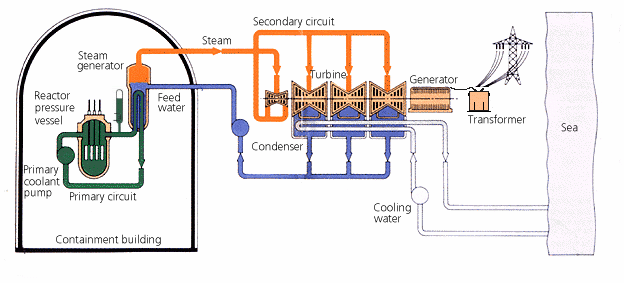Basic operating principles of nuclear power station using pressurised water reactor
Nuclear power station with pressurised water reactor is basically divided into the "nuclear island" where steam is produced in the steam generator by nuclear power generated from a reactor, a "conventional island" where steam supplied from the nuclear island is used to drive the turbine-generator to produce electricity, and the Balance of Plant (BOP) which consists of the station auxiliaries and ancillary plants, etc.
In the "nuclear island", heat is produced by nuclear fission in the reactor and delivered by pressurised water in the primary coolant circuit to the steam generator (a heat exchanger), which converts the feed water in the secondary circuit to high-pressure steam at about 67 bar (or 6 700 kPa) and deliver it to the "conventional island" via steam pipe for driving the turbine and generator.
In the "conventional island", the steam will pass through the multi-stage turbines and then discharge into the condensers where the steam is condensed to liquid water (condensate). This condensate discharge from the condensers (feed water) is pumped back to the steam generator in the nuclear island to be converted into steam again. Cooling water for the condensers is taken from the sea via the seawater pumps in the pump house. During the process, the steam will spin the turbine generator at high speed (the rated speed for the turbine generators used in GNPS and LNPS Phase 1 is 3000 revolutions per minute and that in LNPS Phase 2 is 1500 revolutions per minute), which then generates electricity to complete the energy conversion process.

Nuclear power station using pressurised water reactor